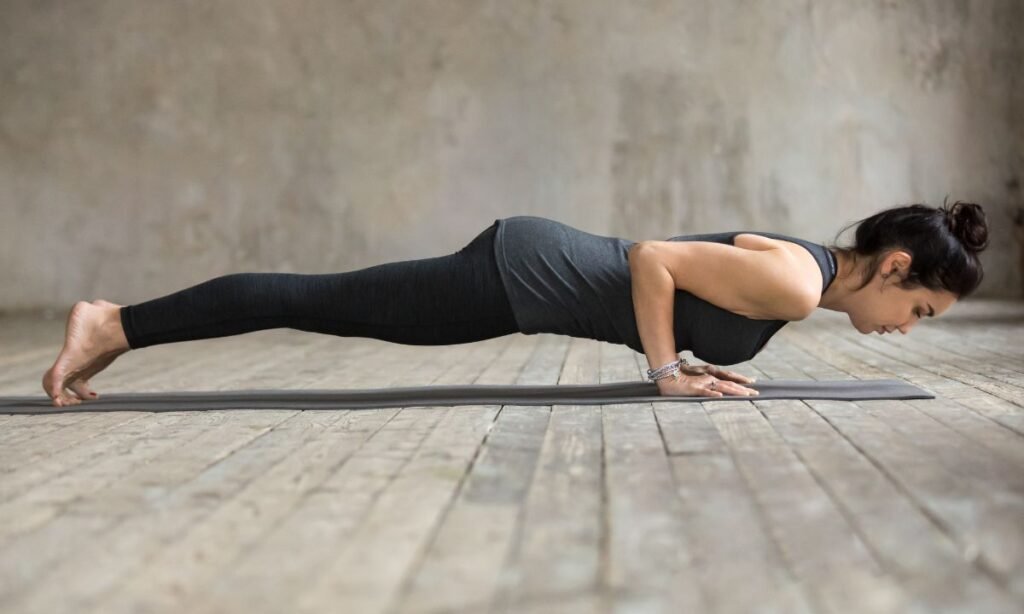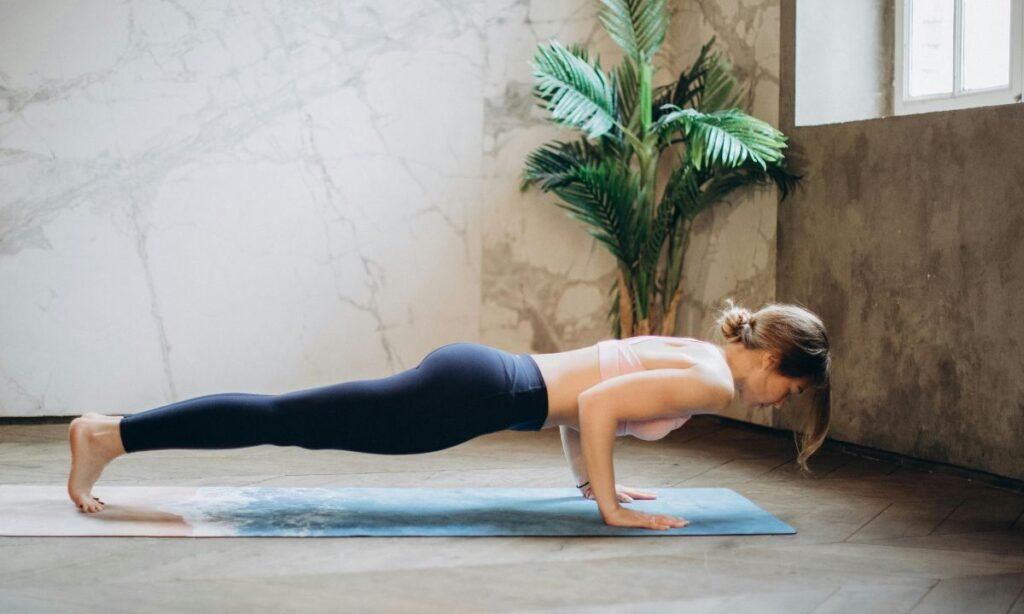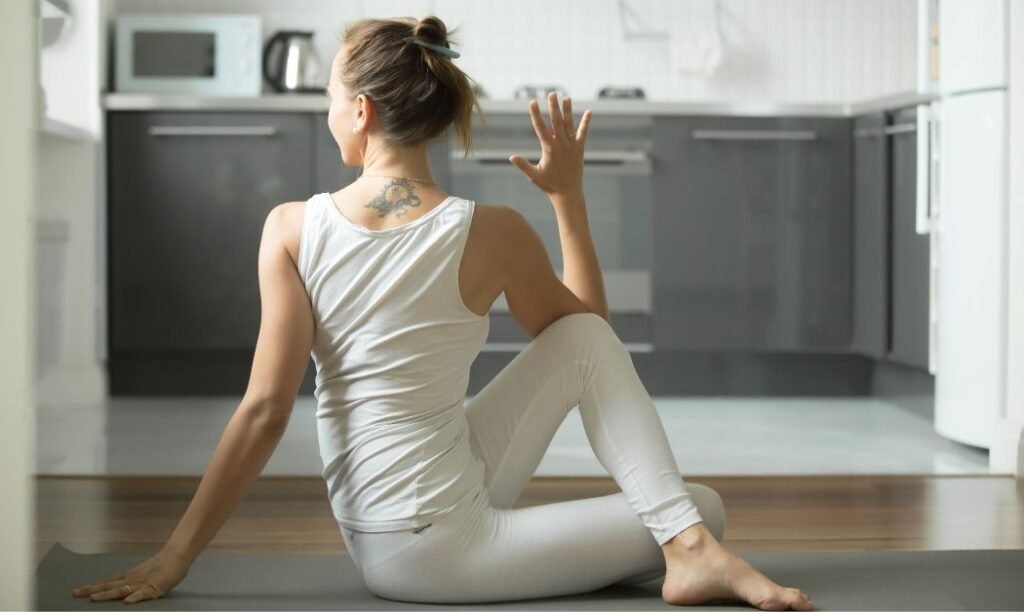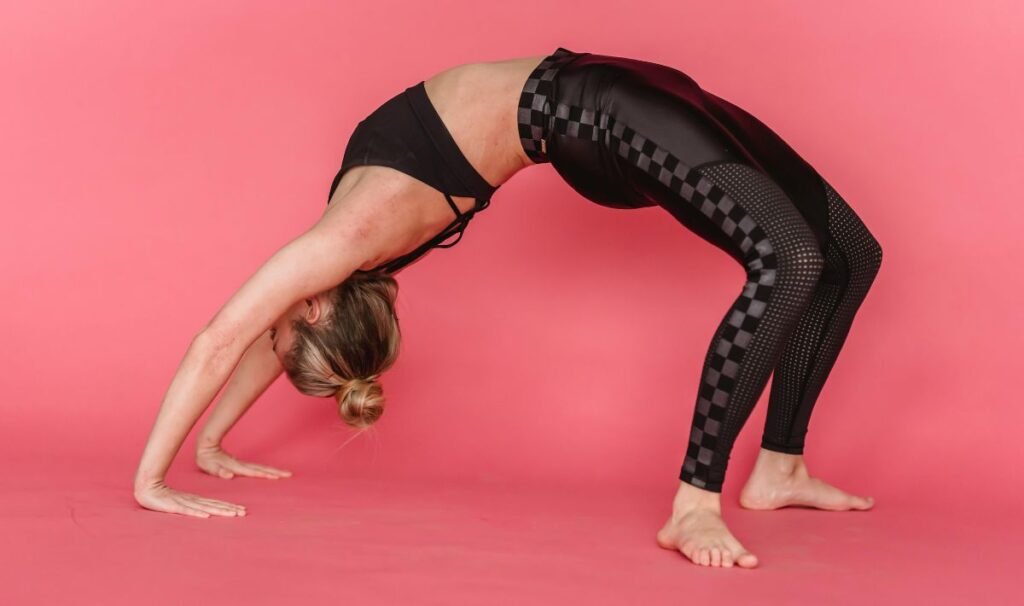Chaturanga Dandasana, also known as the Four-Limbed Staff Pose, is one of the core poses in modern yoga practice. While it may seem simple at first glance, Chaturanga is a powerful pose that requires strength, balance, and precision. Mastering this pose can significantly enhance your overall yoga practice. In this article, we’ll dive deep into the essence of Chaturanga Dandasana, its benefits, how to practice it, and why it’s such an important part of yoga sequences like Vinyasa and Ashtanga.
Chaturanga Dandasana is one of the most widely practiced poses in yoga, especially in flow-based practices like Vinyasa and Ashtanga yoga. Often referred to simply as “Chaturanga,” it serves as a transition pose in many yoga sequences, making it a foundational element of the practice.
The name “Chaturanga Dandasana” comes from the Sanskrit words:
- Chatur means “four”
- Anga means “limb”
- Danda means “staff” or “stick”
- Asana means “pose” or “posture”
In essence, the Four-Limbed Staff Pose symbolizes the body as a staff, held strong and steady on four points of contact: the hands and feet. Practicing Chaturanga requires strength in the arms, shoulders, core, and legs. When done correctly, it helps build stability and prepares you for more advanced yoga poses.
What is Chaturanga Dandasana? (Four-Limbed Staff Pose Explained)
Chaturanga Dandasana is a low plank position, with the body parallel to the ground and supported by the hands and feet. It is often a part of Sun Salutations (Surya Namaskar) and serves as a transition between Plank Pose and Upward-Facing Dog (Urdhva Mukha Svanasana).
This pose mimics the action of lowering down for a push-up but involves much more precision and control. Instead of collapsing the chest and rounding the back, the aim is to keep the body in a straight line from head to heels while engaging the core muscles.
The Four-Limbed Staff Pose is an essential pose for those looking to build strength in yoga, especially for those who want to progress into more advanced arm balances and inversions.
How to Do Chaturanga Dandasana: Step-by-Step Guide

Chaturanga Dandasana may look like a simple push-up, but it requires careful alignment and muscle engagement. Here’s a step-by-step guide to ensure you’re practicing it correctly:
Step-by-Step Instructions:
- Start in Plank Pose: Begin by aligning your body in Plank Pose, with your wrists directly under your shoulders and your body in a straight line.
- Engage the Core: Activate your abdominal muscles by drawing your navel toward your spine. This will help maintain a straight back throughout the movement.
- Shift Forward: Slowly shift your body forward by rolling onto the tips of your toes. Your shoulders should come slightly ahead of your wrists.
- Lower Down: Begin to lower your body towards the ground, keeping your elbows tight to your sides. Your elbows should bend at a 90-degree angle, with your forearms parallel to the ground.
- Keep the Body Straight: Avoid sagging in your hips or letting your shoulders collapse. Your body should form a straight line from the crown of your head to your heels.
- Hover Above the Ground: Instead of dropping your chest to the floor, hover an inch or two above the mat. Keep your shoulders lifted and your elbows directly above your wrists.
- Hold the Pose: Stay in this position for a breath or two, maintaining control and alignment.
- Exit the Pose: From Chaturanga, you can transition into an Upward-Facing Dog or Lower to the floor for Cobra Pose.
Readmore: How Yoga Aligns Your Chakras for Better Energy Flow
Readmore: Top 5 Yoga Festivals You Should Attend This Year
Mistakes in Chaturanga and How to Avoid Them
Like many yoga poses, Chaturanga Dandasana requires attention to detail. Here are some common mistakes and tips for avoiding them:
- Mistake 1: Dropping the Hips Too Low
- Many people let their hips sag towards the floor, which can strain the lower back.
- Solution: Engage your core and keep your body in a straight line.
- Mistake 2: Elbows Flaring Out
- Allowing your elbows to flare out away from your body puts unnecessary pressure on your shoulders.
- Solution: Keep your elbows close to your sides as you lower down.
- Mistake 3: Collapsing the Chest
- This occurs when the shoulders dip below the elbows, putting stress on the shoulder joints.
- Solution: Stop lowering once your elbows form a 90-degree angle.
- Mistake 4: Lack of Core Engagement
- Without engaging your core, the pose becomes harder on your arms and shoulders.
- Solution: Draw your navel in and activate your abdominal muscles throughout the pose.
Modifications for Beginners and Advanced Variations
If you’re new to yoga or find Chaturanga challenging, there are modifications and advanced variations to suit your level of practice.
Modifications for Beginners:
- Knee Chaturanga: Lower your knees to the floor while keeping your body in a straight line from head to knees. This reduces the weight on your arms and shoulders, making it easier to practice.
- Use Yoga Blocks: Place blocks under your shoulders to provide support as you lower down, helping you maintain proper alignment without collapsing.
Advanced Variations:
- Floating Chaturanga: In this variation, you hover just above the ground, adding an extra layer of challenge to your core and arm strength.
- Slow Lowering Chaturanga: Slowly lower down over 5-10 seconds, which increases endurance and control.
The Benefits of Chaturanga Dandasana
Chaturanga Dandasana offers numerous physical and mental benefits when practiced consistently and with proper form. Here are some of the key benefits:
Physical Benefits:
- Strengthens the Arms and Shoulders: Chaturanga is a powerful arm and shoulder workout, building strength in the biceps, triceps, and deltoids.
- Tones the Core: The core engagement required in Chaturanga helps tone and strengthen the abdominal muscles.
- Prepares for Arm Balances: Mastering Chaturanga builds the foundation for more advanced arm balances and inversions, such as Crow Pose or Handstand.
- Improves Posture: Regular practice strengthens the muscles around the spine, promoting better posture.
Mental Benefits:
- Increases Focus: Maintaining proper alignment in Chaturanga requires concentration, helping to enhance mental focus.
- Builds Discipline: The strength and endurance needed for Chaturanga help develop mental discipline and perseverance.
Readmore: How to Master Thunderbolt Pose (Vajrasana)
Readmore: Master Standing Split Yoga Pose
Chaturanga in Yoga Sequences
Chaturanga Dandasana plays a central role in flow-based yoga styles like Vinyasa and Ashtanga. It is often included in the Sun Salutation sequence and serves as a transition pose between the Plank Pose and the Upward-Facing Dog.
Chaturanga in Sun Salutations:
In Sun Salutations, Chaturanga is typically practiced after the Plank Pose and is followed by an Upward-Facing Dog. This flow of poses strengthens the upper body and core, while also providing a dynamic stretch for the chest and shoulders.
Strength-Building Sequences:
You can incorporate Chaturanga into strength-building yoga sequences that target the arms and core. For example:
- Plank Pose → Chaturanga Dandasana → Upward-Facing Dog → Downward-Facing Dog
- Repeat this flow multiple times to build endurance.
Safety Tips and Precautions for Chaturanga
Chaturanga Dandasana is a powerful pose, but it can also lead to injury if practiced incorrectly. Here are some safety tips to keep in mind:
- Warm Up First: Always warm up your body with poses like Plank, Downward Dog, and Cobra before attempting Chaturanga.
- Avoid Shoulder Strain: Make sure your shoulders do not dip below your elbows when lowering down. This can put unnecessary strain on the rotator cuff.
- Use Props if Necessary: If you’re new to Chaturanga, don’t hesitate to use yoga props like blocks to help maintain proper form.
- Modify for Injuries: If you have wrist, shoulder, or lower back injuries, it’s best to avoid full Chaturanga and stick to modifications like Knee Chaturanga.
Conclusion: Mastering Chaturanga Dandasana
Chaturanga Dandasana, or the Four-Limbed Staff Pose, is a foundational pose in yoga that builds strength, focus, and endurance. While it may take time to master, the benefits of this pose are well worth the effort. Whether you’re a beginner or an advanced practitioner, practicing Chaturanga with proper alignment will help you progress in your yoga journey and prepare you for more challenging poses. So, keep practicing, stay mindful of your form, and enjoy the journey toward mastering this essential yoga pose.
Readmore: 7 Yoga Poses to Boost Self-Confidence & Power
Readmore: The Benefits of Practicing Yoga Outdoors
Frequently Asked Questions (FAQs)
Q: How long should you hold Chaturanga Dandasana?
A: Chaturanga is typically held for 1-3 breaths, but more advanced practitioners may hold it longer to build strength and endurance.
Q: Is Chaturanga Dandasana safe for beginners?
A: Yes, with proper modifications (like lowering the knees) and attention to alignment, beginners can safely practice Chaturanga.
Q: Can Chaturanga Dandasana help build arm strength for handstands?
A: Absolutely! Chaturanga strengthens the arms, shoulders, and core, which are essential for arm balances like Handstand and Crow Pose.

Sonu is a passionate yoga teacher with over 6+ years of experience helping individuals find balance, strength, and inner peace through the transformative power of yoga. As the creator of Pure Yoga Vibes, Sonu shares expert insights, inspiring practices, and a wealth of knowledge to support your wellness journey. Dedicated to creating a space for growth and mindfulness, Sonu’s mission is to make yoga accessible and enjoyable for everyone. For inquiries or collaborations, feel free to reach out at contact@pureyogavibes.com.



